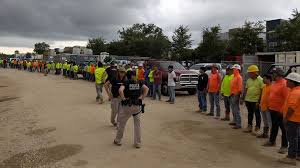
Escalating federal immigration crackdowns are adding new layers of uncertainty to a construction industry already struggling with chronic labor shortages. Recent raids by U.S. Immigration and Customs Enforcement (ICE) have heightened fear on jobsites, triggered absences and callouts, and left contractors bracing for extended project timelines and unexpected costs.

On July 23, ICE agents arrested 11 workers during a raid at an elementary school construction site in Alabama — one of several high-profile actions targeting employers suspected of hiring immigrants without proper work authorization. It’s part of what some experts say is a clear signal that President Donald Trump’s renewed anti-immigration stance is not just rhetoric.
“There’s a fair amount of uncertainty, but relative to inauguration day, we know more than we did,” said Anirban Basu, chief economist for Associated Builders and Contractors. “We now know that the Trump administration is very serious about deportations, even among those who do not have misdemeanor or felony convictions.”
The impact of these raids goes far beyond individual arrests. Brian Turmail, vice president of public affairs and workforce for the Associated General Contractors of America, said his organization began warning members to expect stepped-up enforcement shortly after the election. He noted that ICE’s ramp-up became more likely once the agency secured “unprecedented funding” through the One Big Beautiful Bill, signed on July 4.
“We are warning our members they’re likely to expect even more activity now that they’re better funded and have more resources to use,” Turmail said.
The ripple effect is already showing up. Reports of heightened worker absences and sites posting signs demanding warrants for uninvited visits have become more common. While many contractors follow I-9 and E-Verify protocols to comply with federal law, experts acknowledge those systems aren’t foolproof.
“Everyone understands that if you’ve done E-Verify, you’ve done I-9, you may still have undocumented workers on your jobsite,” Turmail said. Stolen Social Security numbers and forged documents remain common tactics for unauthorized workers seeking jobs.
Larger contractors, too, are beginning to feel the impact. George Carrillo, co-founder and CEO of the Hispanic Construction Council, said “Some of the large general contractors that didn’t necessarily have any sort of worries before, now have worries because some of their jobsites have been hit.”

Carrillo also raised concern about what he calls “collateral damage” — cases where workers not originally targeted by ICE still end up detained and deported. Turmail said the reality is more nuanced and that ICE agents do not always arrest beyond their intended targets, adding to the confusion and stress on jobsites.
The labor squeeze is visible in national data, Basu said, pointing out that unfilled U.S. job openings rose from 7.2 million to 7.8 million between January and March. He believes part of that spike comes from employers scrambling to swap out undocumented labor with documented workers — a swap that’s easier said than done in an industry heavily reliant on immigrant labor.
“Construction is one of the industries that has tended to utilize a significant fraction of undocumented worker capacity. That partial solution is now less accessible,” Basu said.
He added that even healthy backlogs could mask a darker trend. Projects may simply be taking longer to complete because crews are harder to staff. “I have a strong suspicion that the recent strength and backlog that has emerged among many contractors has a lot to do with the fact that it’s taking them longer to complete projects,” Basu said.
Turmail warned the worst-case scenario could see ICE detaining larger numbers of workers with no criminal records, creating sudden gaps in labor. “Which will probably lead to some construction projects getting halted because of lack of workers,” he said.
Industry groups aren’t standing still. Turmail and Carrillo both said they’re pushing for more realistic solutions, including expanded workforce development efforts and comprehensive immigration reform that addresses the millions of undocumented workers already here.
“Our hope and what we’re pushing for is that that’s kind of where they pivot to,” Turmail said. “Like Congress is eager to do something, but is kind of waiting for the Bat Signal from the president.”
One possible lifeline is The Dignity Act of 2025, a bipartisan bill recently introduced in the House. The bill would strengthen border security, overhaul asylum procedures and make E-Verify mandatory for all U.S. employers. Crucially, it would also create a legal path for undocumented immigrants to gain status by passing background checks, paying taxes and enrolling in health insurance.
Carrillo has been in Washington pitching House members on ways to transition undocumented construction workers into legal status. Experts like Basu see signs that sustained economic disruption could eventually push the administration to soften its stance.
“I think that’s exactly what we’re going to see in the quarters ahead,” Basu said, pointing to the potential for hard economic data — and political pressure ahead of the 2026 midterms — to drive a policy recalibration.
But until then, the squeeze on an already strained construction workforce could deepen. “With this immigration policy pushing back on immigration, whether undocumented or documented, that suggests given our nation’s demographics, that if anything, the skilled worker shortage in construction is going to be exacerbated during the years ahead,” Basu said.
Originally reported by Zachary Phillips in Construction Dive.